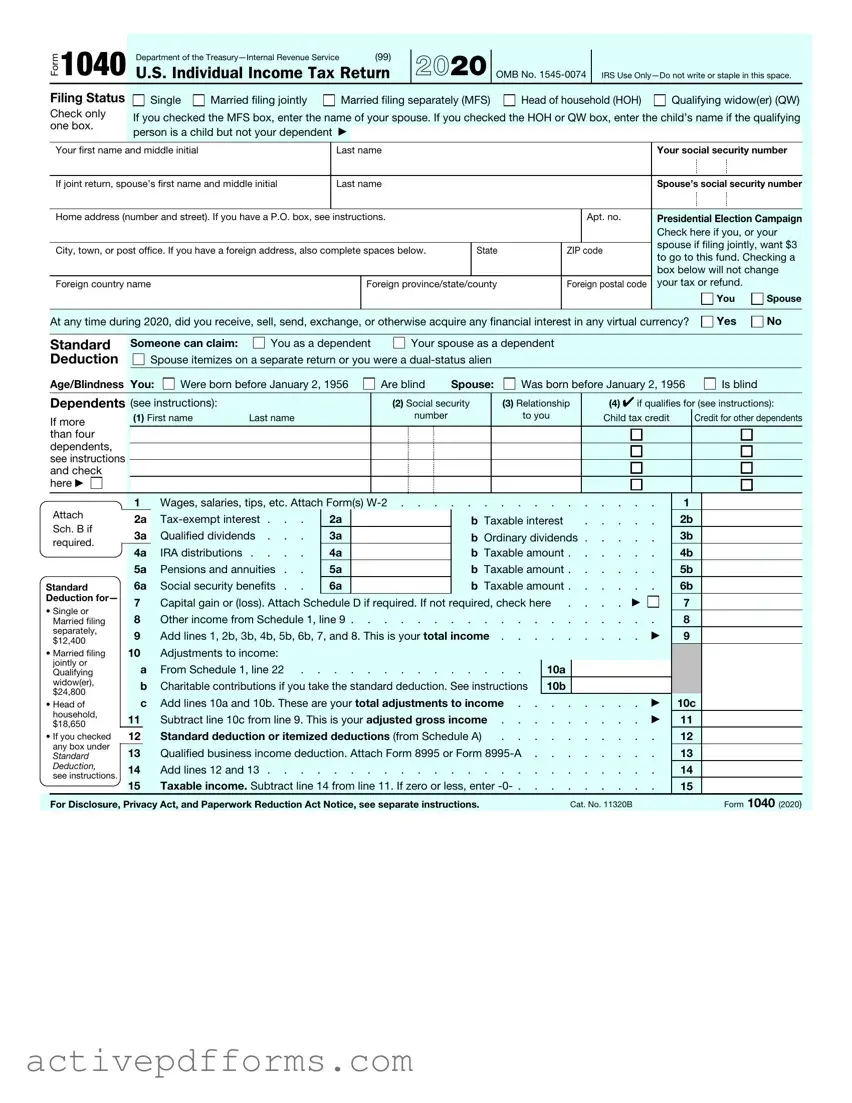|
Your first name and middle initial |
|
|
|
|
Last name |
|
|
|
|
|
|
|
|
|
|
|
|
|
Your social security number |
|
|
|
|
|
|
|
|
|
|
|
|
|
|
|
|
|
|
|
|
|
|
|
|
|
|
|
|
|
|
|
|
|
|
|
|
|
|
|
|
|
|
|
|
|
|
|
|
|
If joint return, spouse’s first name and middle initial |
Last name |
|
|
|
|
|
|
|
|
|
|
|
|
|
Spouse’s social security number |
|
|
|
|
|
|
|
|
|
|
|
|
|
|
|
|
|
|
|
|
|
|
|
|
|
|
|
|
|
|
|
|
|
|
|
|
|
|
|
|
|
|
|
|
|
|
|
|
|
Home address (number and street). If you have a P.O. box, see instructions. |
|
|
|
|
|
|
|
|
|
Apt. no. |
Presidential Election Campaign |
|
|
|
|
|
|
|
|
|
|
|
|
|
|
|
|
|
|
|
|
|
|
|
|
|
|
|
|
|
|
|
|
|
|
|
|
|
|
|
|
Check here if you, or your |
|
|
|
|
|
|
|
|
|
|
|
|
|
|
|
|
|
|
|
|
|
|
|
|
|
|
|
|
|
|
|
|
|
|
|
|
|
|
|
|
spouse if filing jointly, want $3 |
|
City, town, or post office. If you have a foreign address, also complete spaces below. |
|
State |
|
|
|
|
ZIP code |
|
|
|
|
|
|
to go to this fund. Checking a |
|
|
|
|
|
|
|
|
|
|
|
|
|
|
|
|
|
|
|
|
|
|
|
|
|
|
|
|
|
|
|
|
|
|
|
|
|
|
|
|
|
|
|
|
|
|
|
|
|
|
|
|
|
|
|
|
|
|
|
|
|
|
|
|
|
|
|
|
|
|
|
|
|
|
|
|
|
|
|
|
box below will not change |
|
Foreign country name |
|
|
|
|
|
|
|
|
|
|
Foreign province/state/county |
|
|
|
|
Foreign postal code |
your tax or refund. |
|
|
|
|
|
|
|
|
|
|
|
|
|
|
|
|
|
|
|
|
|
|
|
|
|
|
|
|
|
|
|
|
|
|
|
|
|
|
|
|
|
|
|
|
|
|
|
|
|
|
|
You |
|
|
Spouse |
|
|
|
|
|
|
|
|
|
|
|
|
|
|
|
|
|
|
|
|
|
|
|
|
|
|
|
|
|
|
|
|
|
|
|
|
|
|
|
|
|
|
|
|
|
|
|
|
|
|
|
|
|
|
|
|
|
|
|
|
|
|
|
|
|
|
|
|
|
|
|
|
|
|
|
|
|
|
|
|
|
|
|
|
|
|
|
|
|
|
|
|
|
|
|
|
|
|
|
|
|
|
|
|
|
|
At any time during 2021, did you receive, sell, exchange, or otherwise dispose of any financial interest in any virtual currency? |
|
|
|
|
|
|
Yes |
|
|
No |
|
|
|
|
|
|
|
|
|
|
|
|
|
|
|
|
|
|
|
|
|
|
|
|
|
|
|
|
|
|
|
|
|
|
|
|
|
|
|
|
|
|
|
|
|
|
|
|
|
|
|
|
|
|
|
|
|
|
|
|
|
|
|
|
Standard |
|
Someone can claim: |
|
|
|
You as a dependent |
|
|
Your spouse as a dependent |
|
|
|
|
|
|
|
|
|
|
|
|
|
|
|
|
|
|
|
|
|
|
|
|
|
|
|
|
|
|
|
|
|
|
|
|
|
|
|
|
|
|
|
|
|
|
|
|
|
|
|
|
|
|
|
|
|
|
|
|
|
|
|
|
|
|
|
|
|
|
Deduction |
|
|
|
|
|
Spouse itemizes on a separate return or you were a dual-status alien |
|
|
|
|
|
|
|
|
|
|
|
|
|
|
|
|
|
|
|
|
|
|
|
|
|
|
|
|
|
|
|
|
|
|
|
|
|
|
|
|
|
|
|
|
|
|
|
|
|
|
|
|
|
|
|
|
|
|
|
|
|
|
|
|
|
|
|
|
|
|
|
|
|
|
|
|
|
|
|
|
|
|
|
|
|
|
|
|
|
|
|
|
|
|
|
Age/Blindness You: |
|
|
Were born before January 2, 1957 |
|
|
Are blind |
Spouse: |
|
|
Was born before January 2, 1957 |
|
|
|
|
Is blind |
|
|
|
|
|
|
|
|
|
|
|
|
|
|
|
|
|
|
|
|
|
|
|
|
|
|
|
|
|
|
|
|
|
|
|
|
|
|
|
|
|
|
|
|
|
|
|
|
|
|
Dependents (see instructions): |
|
|
|
|
|
|
|
|
|
(2) Social security |
|
(3) Relationship |
(4) ✔ if qualifies for (see instructions): |
|
If more |
|
|
(1) First name |
Last name |
|
|
|
|
|
|
|
number |
|
|
|
|
|
to you |
Child tax credit |
|
|
Credit for other dependents |
|
|
|
|
|
|
|
|
|
|
|
|
|
|
|
|
|
|
|
|
|
|
|
|
|
|
|
|
|
|
|
|
|
|
|
|
|
|
|
|
|
|
|
|
|
|
|
|
|
|
|
|
than four |
|
|
|
|
|
|
|
|
|
|
|
|
|
|
|
|
|
|
|
|
|
|
|
|
|
|
|
|
|
|
|
|
|
|
|
|
|
|
|
|
|
|
|
|
|
|
|
|
|
|
|
|
|
|
|
|
|
|
|
|
|
|
|
|
|
|
|
|
|
|
|
|
|
|
|
|
|
|
|
|
|
|
|
|
|
|
|
|
|
|
|
|
|
|
|
|
|
|
|
|
|
|
dependents, |
|
|
|
|
|
|
|
|
|
|
|
|
|
|
|
|
|
|
|
|
|
|
|
|
|
|
|
|
|
|
|
|
|
|
|
|
|
|
|
|
|
|
|
|
|
|
|
|
|
|
|
|
|
|
|
|
|
|
|
|
|
|
|
|
|
|
|
|
|
|
|
|
|
|
|
|
|
|
|
|
|
|
|
|
|
|
|
|
|
|
|
|
|
|
|
|
|
|
|
|
|
|
|
|
|
|
|
|
|
|
|
|
|
|
|
|
|
|
|
|
|
|
|
|
|
|
|
|
|
|
|
|
|
|
|
|
|
|
|
|
|
|
|
|
|
|
|
|
|
|
|
|
|
see instructions |
|
|
|
|
|
|
|
|
|
|
|
|
|
|
|
|
|
|
|
|
|
|
|
|
|
|
|
|
|
|
|
|
|
|
|
|
|
|
|
|
|
|
|
|
|
|
|
|
|
|
|
|
|
|
|
|
|
|
|
|
|
|
|
|
|
|
|
|
|
|
|
|
|
|
|
|
|
|
|
|
|
|
|
|
|
|
|
|
|
|
|
|
|
|
|
|
|
|
|
|
|
|
|
|
|
|
|
|
|
|
|
|
|
|
|
|
|
|
|
|
|
|
|
|
|
|
|
|
|
|
|
|
|
|
|
|
|
|
|
|
|
|
|
|
|
|
|
|
|
|
|
|
|
and check |
|
|
|
|
|
|
|
|
|
|
|
|
|
|
|
|
|
|
|
|
|
|
|
|
|
|
|
|
|
|
|
|
|
|
|
|
|
|
|
|
|
|
|
|
|
|
|
|
|
|
|
|
|
|
|
|
|
|
|
|
|
|
|
|
|
|
|
|
|
|
|
|
|
|
|
|
|
|
|
|
|
|
|
|
|
|
|
|
|
|
|
|
|
|
|
|
|
|
|
|
|
|
here ▶ |
|
|
|
|
|
|
|
|
|
|
|
|
|
|
|
|
|
|
|
|
|
|
|
|
|
|
|
|
|
|
|
|
|
|
|
|
|
|
|
|
|
|
|
|
|
|
|
|
|
|
|
|
|
|
|
|
|
|
|
|
|
|
|
|
|
|
|
|
|
|
|
|
|
|
|
|
|
|
|
|
|
|
|
|
|
|
|
|
|
|
|
|
|
|
|
|
|
|
|
|
|
|
|
|
|
|
|
|
|
|
|
|
|
|
|
|
|
|
|
|
|
|
|
|
|
|
|
|
|
|
|
|
|
|
|
|
|
|
|
|
|
|
|
|
|
|
|
|
|
|
|
|
|
|
|
|
|
Attach |
|
|
1 |
|
|
|
|
Wages, salaries, tips, etc. Attach Form(s) W-2 |
. |
|
|
1 |
|
|
|
|
|
|
|
|
|
|
|
|
|
|
|
|
2 |
a |
|
|
Tax-exempt interest . . . |
2a |
|
|
|
|
|
|
|
|
b Taxable interest |
. . . . |
|
|
. |
|
|
2b |
|
|
|
|
|
|
|
|
|
|
|
Sch. B if |
|
|
|
|
|
|
|
|
|
|
|
|
|
|
|
|
|
|
|
|
|
|
|
|
|
|
|
|
3 |
a |
|
|
Qualified dividends . . . |
3a |
|
|
|
|
|
|
|
|
b Ordinary dividends . . . . |
. |
|
|
3b |
|
|
|
|
|
|
|
|
|
|
|
required. |
|
|
|
|
|
|
|
|
|
|
|
|
|
|
|
|
|
|
|
|
|
|
|
|
|
|
|
|
4a |
IRA distributions . . . . |
4a |
|
|
|
|
|
|
|
|
b Taxable amount |
. |
|
|
4b |
|
|
|
|
|
|
|
|
|
|
|
|
|
|
|
|
|
|
|
|
|
|
|
|
|
|
|
|
|
|
|
|
|
|
|
|
|
|
|
|
|
5a |
Pensions and annuities . . |
5a |
|
|
|
|
|
|
|
|
b Taxable amount |
. |
|
|
5b |
|
|
|
|
|
|
|
|
|
|
Standard |
|
|
6a |
Social security benefits . . |
6a |
|
|
|
|
|
|
|
|
b Taxable amount |
. |
|
|
6b |
|
|
|
|
|
|
|
|
|
|
Deduction for— |
7 |
|
|
|
|
Capital gain or (loss). Attach Schedule D if required. If not required, check here . |
. . . ▶ |
|
|
|
|
7 |
|
|
|
|
|
|
|
|
|
|
|
|
|
|
|
|
|
|
|
|
|
|
|
|
|
|
|
|
|
|
• Single or |
|
|
|
|
|
|
|
|
|
|
|
|
|
|
|
|
|
|
|
|
|
|
|
|
|
|
|
|
|
|
|
|
|
|
|
|
|
|
|
|
|
|
|
|
|
|
|
|
|
|
|
|
|
|
|
|
|
|
|
|
|
|
|
|
|
|
|
|
|
8 |
|
|
|
|
Other income from Schedule 1, line 10 |
. |
|
|
8 |
|
|
|
|
|
|
|
|
|
|
|
|
Married filing |
|
|
|
|
|
|
|
|
|
|
|
|
|
|
|
|
|
|
separately, |
9 |
|
|
|
|
Add lines 1, 2b, 3b, 4b, 5b, 6b, 7, and 8. This is your total income |
▶ |
|
9 |
|
|
|
|
|
|
|
|
|
|
|
$12,550 |
|
|
|
|
|
|
|
|
|
|
|
|
|
|
|
|
|
|
|
• Married filing |
10 |
|
|
|
|
Adjustments to income from Schedule 1, line 26 |
. |
|
|
10 |
|
|
|
|
|
|
|
|
|
|
|
jointly or |
11 |
|
|
|
|
Subtract line 10 from line 9. This is your adjusted gross income |
. . . . . . . . . |
|
|
▶ |
|
11 |
|
|
|
|
|
|
|
|
|
|
|
Qualifying |
|
|
|
|
|
|
|
|
|
|
|
|
|
|
|
|
|
|
widow(er), |
|
|
|
12 |
a |
|
|
Standard deduction or itemized deductions (from Schedule A) |
. . |
12a |
|
|
|
|
|
|
|
|
|
|
|
|
|
|
|
|
|
|
|
|
$25,100 |
|
|
|
|
|
|
|
|
|
|
|
|
|
|
|
|
|
|
|
|
|
|
|
|
|
|
|
|
|
|
|
b |
Charitable contributions if you take the standard deduction (see instructions) |
12b |
|
|
|
|
|
|
|
|
|
|
|
|
|
|
|
|
|
|
|
|
• Head of |
|
|
|
|
|
|
|
|
|
|
|
|
|
|
|
|
|
|
|
|
|
|
|
|
household, |
|
|
|
c |
Add lines 12a and 12b |
. |
|
|
12c |
|
|
|
|
|
|
|
|
|
$18,800 |
|
|
|
|
|
|
|
|
|
|
|
• If you checked |
13 |
|
|
|
|
Qualified business income deduction from Form 8995 or Form 8995-A |
. |
|
|
13 |
|
|
|
|
|
|
|
|
|
|
|
any box under |
14 |
|
|
|
|
Add lines 12c and 13 |
. . . . . . . . . . . . . . . . . . . . . . |
|
|
. |
|
|
14 |
|
|
|
|
|
|
|
|
|
|
|
Standard |
|
|
|
|
|
|
|
|
|
|
|
|
|
|
|
|
|
|
|
Deduction, |
15 |
|
|
|
|
Taxable income. Subtract line 14 from line 11. If zero or less, enter -0- |
. |
|
|
15 |
|
|
|
|
|
|
|
|
|
|
|
see instructions. |
|
|
|
|
|
|
|
|
|
|
|
|
|
|
|
|
|
|
|
|
|
|
|
|
|
|
|
|
|
|
|
|
|
|
|
|
|
|
|
|
|
|
|
|
|
|
|
|
|
|
|
|
|
|
|
|
|
|
|
|
|
|
|
|
|
|
For Disclosure, Privacy Act, and Paperwork Reduction Act Notice, see separate instructions. |
|
|
|
|
Cat. No. 11320B |
|
|
|
|
|
|
|
|
|
Form 1040 (2021) |



